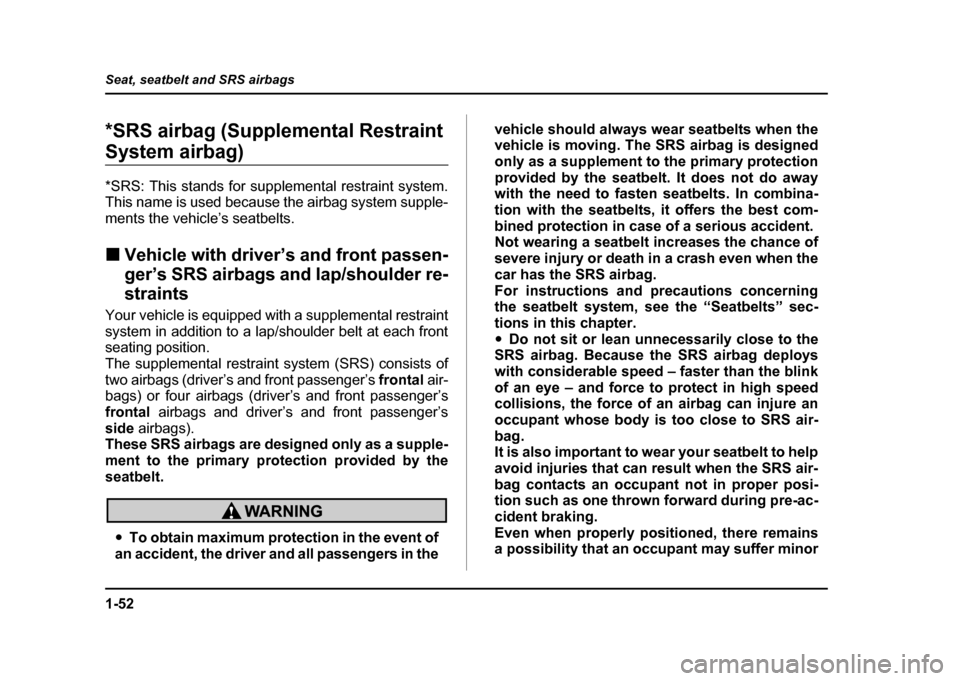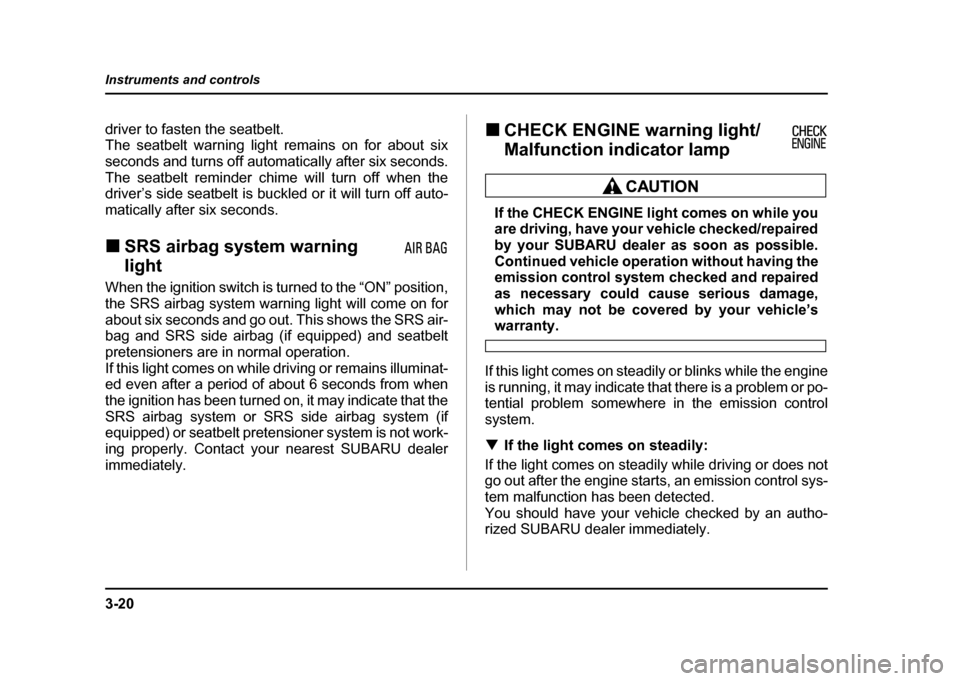airbag off SUBARU IMPREZA 2004 2.G Owners Manual
[x] Cancel search | Manufacturer: SUBARU, Model Year: 2004, Model line: IMPREZA, Model: SUBARU IMPREZA 2004 2.GPages: 491, PDF Size: 5.93 MB
Page 9 of 491

6
Safety precautions when driving !Seatbelt and SRS airbag
"All persons in the vehicle should fasten their
seatbelts BEFORE the vehicle starts to move.
Otherwise, the possibility of serious injury be-
comes greater in the event of a sudden stop or
accident. " To obtain maximum protection in the event of
an accident, the driver and all passengers in the
vehicle should always wear seatbelts when the
vehicle is moving. The SRS (Supplemental Re-
straint System) airbag does not do away with
the need to fasten seatbelts. In combination
with the seatbelts, it offers the best combined
protection in case of a serious accident.
Not wearing a seatbelt increases the chance of
severe injury or death in a crash even when the
car has the SRS airbag. " The SRS airbags deploy with considerable
speed and force. Occupants who are out of
proper position when the SRS airbag deploys
could suffer very serious injuries. Because the
SRS airbag needs enough space for deploy-
Windshield defroster
Rear window defogger/Outside mirror
defogger
Air recirculation
Outside air
Engine oilWasher
Mark Name
Page 33 of 491

1-6
Seat, seatbelt and SRS airbags
1. Slide the front seat forward as far as possible.
2. Pull off the head restraint while pressing the re-
lease button.
3. Recline the seatback rearward up to the lowest po-
sition. Remember to reinstall the head restraint when-
ever the seatback is raised back.
"
Never drive your car with the seats converted
in a flat bed position. If you do so, occupants
will have a greater chance of being injured even
during simple deceleration, acceleration and
cornering since no firm restraint will be avail- able for them. "
Before you lie on the flat bed to take a rest,
read the description “Parking your vehicle” in
Chapter 7 carefully and follow the instructions.
! Active head restraint (if equipped)
The front seats of your vehicle are equipped with ac-
tive head restraints. They automatically tilt forward
slightly in the event the vehicle is struck from the rear,
decreasing the amount of rearward head movement
and thus reducing the risk of whiplash. For maximum
effectiveness the head restraint should be adjust so
HS1040BA
HS1105BA
Page 35 of 491

1-8
Seat, seatbelt and SRS airbags
terior is warmed enough or before you leave the vehi-
cle, be sure to turn the switch off.
"
There is a possibility that people with delicate
skin may suffer slight burns even at low tem-
peratures if he/she uses the seat heater for a
long period of time. When using the heater, al-
ways be sure to warn the persons concerned. " Do not put anything on the seat which insu-
lates against heat, such as a blanket, cushion,
or similar items. This may cause the seat heater
to overheat.
NOTE " Use of the seat heater for a long period of time
while the engine is not running can cause battery
discharge. " When cleaning the seat, do not use benzine,
paint thinner, or any similar materials.
Rear seats
Seatbelts provide maximum restraint when the
occupant sits well back and upright in the seat.
Do not put cushions or any other materials be-
tween occupants and seatbacks or seat cush-
ions. If you do so, the risk of sliding under the
lap belt and of the lap belt sliding up over the
abdomen will increase, and both can result in
serious internal injury or death.
HG1044BA
Page 79 of 491

1-52
Seat, seatbelt and SRS airbags
*SRS airbag (Supplemental Restraint
System airbag)
*SRS: This stands for supplemental restraint system.
This name is used because the airbag system supple-
ments the vehicle’s seatbelts. !
Vehicle with driver’s and front passen-
ger’s SRS airbags and lap/shoulder re-straints
Your vehicle is equipped with a supplemental restraint
system in addition to a lap/shoulder belt at each front
seating position.
The supplemental restraint system (SRS) consists of
two airbags (driver’s and front passenger’s frontal air-
bags) or four airbags (driver’s and front passenger’sfrontal airbags and driver’s and front passenger’s
side airbags).
These SRS airbags are designed only as a supple-
ment to the primary protection provided by the
seatbelt.
" To obtain maximum protection in the event of
an accident, the driver and all passengers in the vehicle should always wear seatbelts when the
vehicle is moving. The SRS airbag is designed
only as a supplement to the primary protection
provided by the seatbelt. It does not do away
with the need to fasten seatbelts. In combina-
tion with the seatbelts, it offers the best com-
bined protection in case of a serious accident.
Not wearing a seatbelt increases the chance of
severe injury or death in a crash even when the
car has the SRS airbag.
For instructions and precautions concerning
the seatbelt system, see the “Seatbelts” sec-
tions in this chapter."
Do not sit or lean unnecessarily close to the
SRS airbag. Because the SRS airbag deploys
with considerable speed – faster than the blink
of an eye – and force to protect in high speed
collisions, the force of an airbag can injure an
occupant whose body is too close to SRS air-
bag.
It is also important to wear your seatbelt to help
avoid injuries that can result when the SRS air-
bag contacts an occupant not in proper posi-
tion such as one thrown forward during pre-ac-
cident braking.
Even when properly positioned, there remains
a possibility that an occupant may suffer minor
Page 89 of 491

1-62
Seat, seatbelt and SRS airbags
plunges into a deep ditch, is severely bumped or
knocked hard against an obstacle on the road such as a curb). "
When is the SRS frontal airbag unlikely to de-
ploy? There are many types of collisions which might not
necessarily require SRS frontal airbag deployment. If
the vehicle strikes an object, such as a telephone pole
or sign pole, or if it slides under a truck’s load bed, or
if it sustains an oblique offset frontal impact, the SRS
frontal airbag may not deploy depending on the level
of accident forces involved.
UG1083BA
Page 157 of 491

3-20
Instruments and controls
driver to fasten the seatbelt.
The seatbelt warning light remains on for about six
seconds and turns off automatically after six seconds.
The seatbelt reminder chime will turn off when the
driver’s side seatbelt is buckled or it will turn off auto-
matically after six seconds. !
SRS airbag system warning light
When the ignition switch is turned to the “ON” position,
the SRS airbag system warning light will come on for
about six seconds and go out. This shows the SRS air-
bag and SRS side airbag (if equipped) and seatbelt
pretensioners are in normal operation.
If this light comes on while driving or remains illuminat-
ed even after a period of about 6 seconds from when
the ignition has been turned on, it may indicate that the
SRS airbag system or SRS side airbag system (if
equipped) or seatbelt pretensioner system is not work-
ing properly. Contact your nearest SUBARU dealer
immediately. !
CHECK ENGINE warning light/
Malfunction indicator lamp
If the CHECK ENGINE light comes on while you
are driving, have your vehicle checked/repaired
by your SUBARU dealer as soon as possible.
Continued vehicle operation without having the
emission control system checked and repaired
as necessary could cause serious damage,
which may not be covered by your vehicle’s
warranty.
If this light comes on steadily or blinks while the engine
is running, it may indicate that there is a problem or po-
tential problem somewhere in the emission controlsystem. ! If the light comes on steadily:
If the light comes on steadily while driving or does not
go out after the engine starts, an emission control sys-
tem malfunction has been detected.
You should have your vehicle checked by an autho-
rized SUBARU dealer immediately.